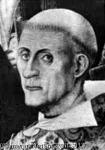Bernt Notke
Bernt Notke
Place: Pomerania
Born: 1440
Death: 1509
Biography:
Bernt Notke (help·info) (c. 1440 – before May 1509) was a late Gothic artist, working in the Baltic region. He has been described as one of the foremost artists of his time in northern Europe.
Very little is known about the life of Bernt Notke. The Notke family came from Tallinn (Estonia) and his father was probably the trader and ship-owner Michel Notke, who had his main business there. His mother was probably Michel's second wife Gertraut, who was from Visby. Bernt Notke was born in the small town of Lassan in Pomerania. He was married (at least once), but the name of his wife remains unknown; she died before he did and is not mentioned in his last will and testament. The couple is known to have had two daughters, one named Anneke and another whose name has not been preserved and who seems to have suffered from intellectual disability.
He seems to have spent part of his youth in Flanders and there begun to learn his trade as an artist. He probably worked in the workshop of tapestry weaver Pasquier Grenier in Tournai, where he learnt to work on art objects of a large scale. He probably also learnt how to divide the labour in a workshop in a contemporary way there, as several of his own works were large, communal undertakings (see below). In the early 1460s he settled in Lübeck, where he would continue to live for the larger part of his life, although he would also intermittently live in Sweden and frequently traveled to cities around the Baltic Sea. He is mentioned in written sources for the first time by the city council of Lübeck on 14 April 1467. In 1479 he acquired a stone house on Breite Strasse, a prestigious address in Lübeck. He was in Stockholm for a prolonged period 1491 – 1497, during which time he for three years held the office of mint master of the realm in Sweden, but he left the city after the end of the regency of Sten Sture the Elder. After 1497 he lived in Lübeck until his death in 1509. In 1505 he acquired the title of Werkmeister at the Church of Saint Peter.
Medieval art differed from contemporary art in several ways, not least in that while modern artists often work in private studios, the production of medieval art was a communal undertaking in a workshop. This was also the case with Bernt Notke, who was the head of such a workshop. During renovation of the large triumphal cross made by Notke in 1470–77, a note signed by Notke and five co-workers was discovered in a hollow part of one of the sculptures. It lists, apart from Notke himself, a carpenter, a painter and three other artisans. The question whether Notke was first and foremost a painter, a woodworker or simply main organiser and entrepreneur is not clear. He was called "painter" by the city council of Lübeck in a document from 1467. He and his workshop produced art in the form of tapestries, wooden sculptures, and paintings. The main type of artwork produced by the workshop of Bernt Notke was altarpieces, incorporating both sculptures and painting. Encyclopædia Britannica claims that he was also active as an engraver, but this claim is not found in other sources.
It has been pointed out that already the first work known to have been made by Notke (between 1463 – 1466) is of unusual character: it was a 2 metres (6.6 ft) high and at least 26 metres (85 ft) long tapestry depicting the popular late medieval motif of the Danse Macabre (the dance of Death), made for a chapel of St. Mary's Church in Lübeck. It was lost or destroyed but survived in the form of a copy, made in 1701, until 1942, when it was destroyed during the allied bombing of Lübeck in World War II.
A second Danse Macabre, made at approximately the same time as the one in Lübeck, survives in part (c. 7 metres (23 ft)) Tallinn (Estonia), in St. Nicholas' Church. It has been suggested that the fragment in Tallinn may have been a piece cut out from the Lübeck Danse Macabre, but this is not certain. Regardless, both display the characteristic vivid expressionism that would become characteristic for Notke.
In 1470 – 1478, Notke executed a very large sculpture group, a so-called triumphal cross (in English sometimes referred to as a rood) for display in Lübeck Cathedral. It consists of a total of 72 sculptures and is made of oak wood; dendrochronology has confirmed that the wood comes from oak trees felled near Lübeck c. 1470. The ensemble has been praised for its realism, monumentality and expressiveness. The patron ordering the art-piece was bishop Albert Krummedik. Notke and his workshop also executed an elaborate gallery in Lübeck Cathedral, ordered by the mayor of Lübeck Andreas Geverdes (de).
In 1479 the altarpiece of Aarhus Cathedral in Denmark was inaugurated, another monumental work from Notke's workshop. As with the Lübeck triumphal cross, it was commissioned by an important member of the clergy, bishop Jens Iversen (Lange) (da). With its 12 metres (39 ft) of height, it was at the time the largest altarpiece in the Nordic countries. It consists of a large number of sculptures, where the central panel contains three large, dominating sculptures of Saint Anne, John the Baptist and Pope Clement I. The altarpiece is signed by Bernt Notke in three places. Influences from the early Northern Renaissance that began to spread from the Low Countries at this time can be traced in the realistic portraiture of some of the sculptures.
More...
Wikipedia link: Click Here


